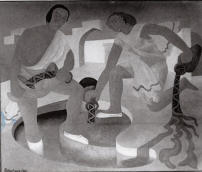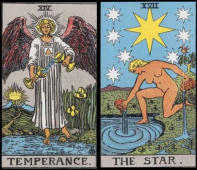



All texts copyright Richard Shillitoe
decorations for the hospital at
moreton in march 1936/7
Moreton in Marsh is a town that lies approximately twenty-three miles by road from Colquhoun’s home town
of Cheltenham. She was comissioned to paint three works in connection with a refurbishment carried out in
1935. Only the first work had been finished in time for the opening ceremony in January 1936.
1. DECORATION FOR THE HOSPITAL OF MORETON IN MARSH, GLOUCESTERSHIRE: WAITING ROOM Room
Oil on board.
80 x 67in. (203.2 x 170.1cm.)
Signed ’Colquhoun/37’ lower left.
Provenance
Untraced.
Exhibited
London, Tate Gallery, 1939, no. 23 (an exhibition of photographs).
This large painting shows two monumental figures, one male and one female, at a well. The setting, of
fragmentary architectural features, is reminiscent of the blank buildings seen in earlier student work.
The “Gloucestershire Echo” described the mural as:
an ultra-modern representation of health. [It] contains two
figures – a man and a woman – bathing at a well. The
completed effort is symbolic of the waters of health,
sunshine, the health and strength of outdoor life.
What the journalist did not say was the symbolism and the figures derive
directly from two of the Major Arcana cards of the Taro pack:
Temperance and The Star.
The figure on the right represents The Star, the 17th trump. She kneels by the well with one foot in the water
and the other on the land. In each hand she holds a jug. From one she pours a liquid into the water. From the
other jug she pours a liquid onto the land. Symbolically, the pool of water refers to the spiritual world and
the land refers to the material world. The woman renews both with the Water of Life.
The figure on the left represents Temperance, the 14th Taro trump. Colquhoun has departed somewhat from
the image in the Rider-Waite-Smith pack in depicting the figure as sitting rather than standing, and having
both feet in the water rather than one on land. The figure is male, but with androgynous features, and pours
the essences of life from a golden chalice into a silver one. The union of the essences produces the elixir of
life.
2. DRAWING FOR A MURAL ‘BENEDICT YAE’
Gouache and pencil.
15½ x 26¾in. (39.7 x 68.5cm.)
Inscribed with the title. Signed and inscribed verso ‘Decoration for a children’s waiting room in a hospital’.
Provenance
NT.
Literature
Ratcliffe, 2007, ill. b/w pl. 59.
At the lower centre a day-dreaming child reclines on a chaise longue. The rest of the composition depicts her
reverie – a fantasy island with high cliffs, at the centre of which stands a large stately home or castle with a
central courtyard.
Annotations on the mount indicate that this work was carried out in connection with the murals for Moreton
in Marsh Hospital. There is no evidence that it was ever installed. The meaning of the phrase ‘Benedict YAE’
remains to be determined.
A related drawing, which shows the mural as it might appear on the wall exists. Correspondence in the Tate
exhibition file reveals that Colquhoun offered a ‘full size cartoon and a small sketch in watercolour’ for the
exhibition in addition to the photographs. It is possible that these were the present work and its associated
drawing.
3. WATER-FLOWER
Oil on canvas.
41 x 30in. (104.1 x 76.2cm.)
Provenance
Sold by the Orion Gallery, 1973.
Exhibited
London, Mayor Gallery, 1939, no. 11.
London, Tate Gallery, 1939, no. 23.
Harrogate, Art Gallery, 1941, no. 24.
London, Hamet Gallery, 1971, ex cat.
Penzance, Orion Gallery, 1973, no. 10, ill. b/w
Literature
Ratcliffe, 2007, ill. col. pl. 27.
A photograph of this work is labelled Decorations for the hospital of Moreton in Marsh, Gloucestershire 1)
Woman’s Ward. It is doubtful that it was ever displayed at the hospital as it was exhibited at the Mayor
Gallery in 1939 and then remained in the artist’s possession until its sale in 1973.
In style, it is very different to the other murals intended for the hospital. It is much more in keeping with
other flower paintings of the period. In fact, none of the three mural paintings share a unity of style or
subject matter.




















